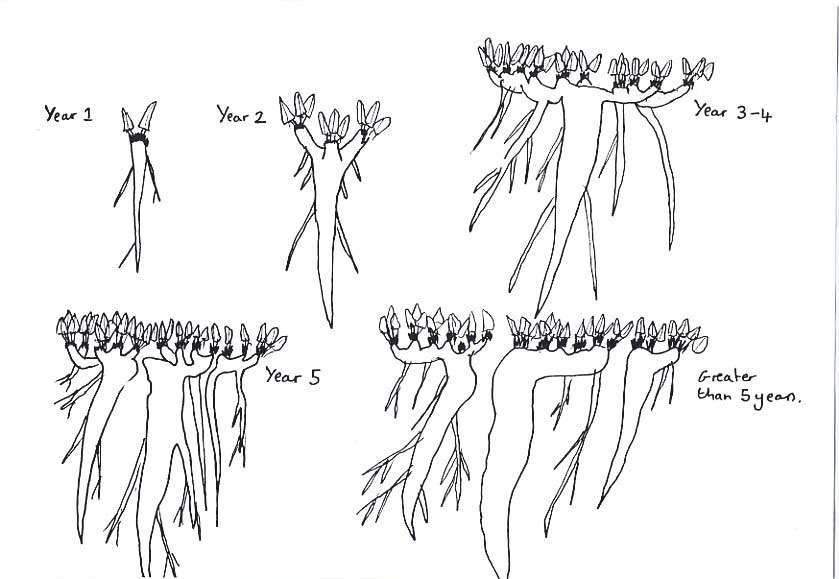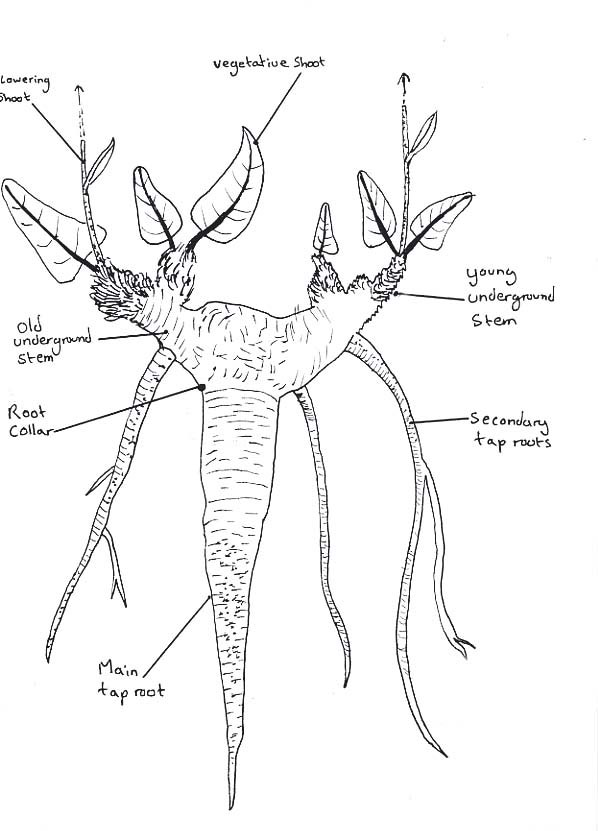Report T032 *****
Problem:
Docks in temporary (but long term) grass
Where: Hill Top Farm, Spaunton, North Yorkshire(The Moorfield
trial)
When: April / May 2004
Area: 7.5 acres
Status: Organic
Detail: Remove 12000 Docks & Compost them. HDRA monitored.
Cost £100 per acre
click drawing for larger version
click drawing for larger version
The field was being grazed by sheep with young lambs, so plant location was no problem. Acid sandy soil, well liked by docks. Likely cause of problem was contaminated feed fed to over-wintered lambs, annually.
Action taken: The field was divided into manageable areas, by marking out tramlines with a vehicle. Work started on the southern boundary fence. Visits to the field were recorded carefully, along with working hours and numbers of docks pulled and loaded into tractor bucket and trailer.
Work-Rate: Each member of the workforce removed 99 docks per hour, and was able to keep up this rate all day.
Results: Over 12000 docks were removed at a cost of just over £100 per acre. Pay was £7. 50p. per hour. This cost might have been less if the work had been continuous instead of comprising several visits.
See Docks in grassland & Arable (Ref. D.030). See also details below:
Acreage: 7.2
Soil type: sandy / acid (requires lime)
Current status: Long term temporary grass, used for spring grazing and summer conservation.
Date of RIP work : 27 April / 14th May 2004
Total Docks removed (including seedlings),: 10,183.
Time taken to pull & remove: 102.5 pulling-hours
Method used: L-Dog & NO8 Fork. (a L-D tool with NO1b fitted was also available for awkward roots). After removal, the docks were thrown into piles & counted into a tractor bucket
before loading into a trailer.These are to be shredded & composted with FYM.
Theoretical Density: 1414 per acre.
(or 196 per 25 square yds.)
Density of surface observable plant clusters would appear less.
Rate of pulling: 99.34 Docks per working hour
Cost @£7.50 per hour Cost per acre = £106.77p
Cost @£8.00 per hour Cost per acre = £113.88p
Cost @£10.00 per hour Cost per acre = £142.36p
Add to these costs for a ‘follow up’ or walking of the field, to pick up missed or emerging plants.
This work took 9 man-hours, produced another 1242 small plants, and brought the total number of docks removed to 1142…………………….. Cost per acre = £7 to £8.
Before mowing follow-up (JUNE 30th) 564 plants removed in 8hrs @ £60.(50% curled Dock & 50% from broken roots or fragments.)
CONCLUSION & EVALUATION
What value can be put on clearing dock roots from this arable field ?
- The field can now be used for conservation, without fear of spreading dock seed through animal feed. This would mean no feeding in field racks, and all FYM to be hot composted.
- The field can be grazed, without any need for topping (up to three times) to control seeding docks
- This field is now fit to plough, rotovate, and cultivate without chopping up roots.
- The field could now be expected to grow a valuable potato crop, for which extensive rotavation is required. If the docks had not been removed, two years of cropping would see those multiple rotovated root sections become large and successful plants.
- The field might then require a year of fallow, with extensive dragging and root removal. Considerable time time and energy would be needed, and a year of cropping lost.
- Meanwhile, we have gained 12 to 15 tons of root biomass. This is going to be shredded, and incorporated into a compost, based on wheat-straw sheep bedding. We intend to make three samples of compost (using one similar area of bedding), and get them analysed. Dr John Zarb is overseeing this work, and expects the root rich compost to have some qualities, maybe appropriate in certain areas of horticulture. It is almost inevitable that the incorporation of dock roots will add value of some sort.

